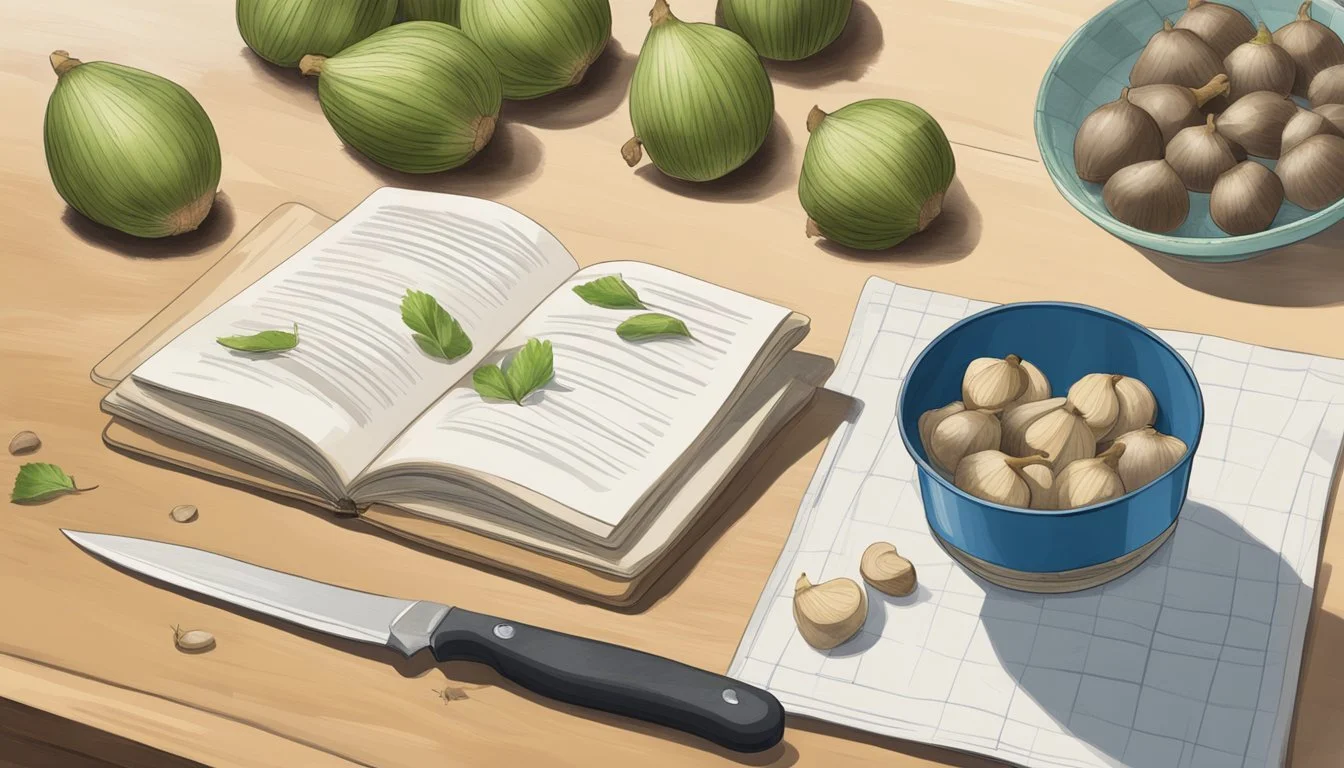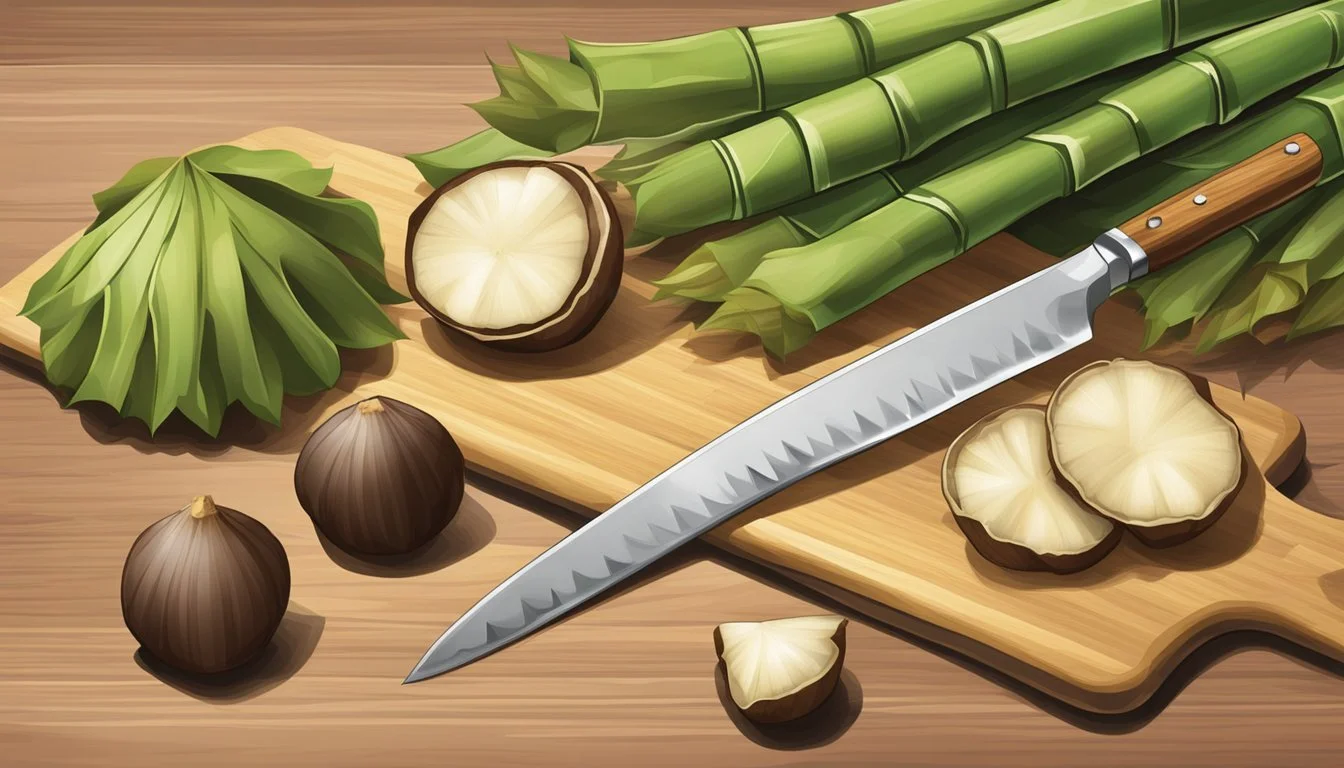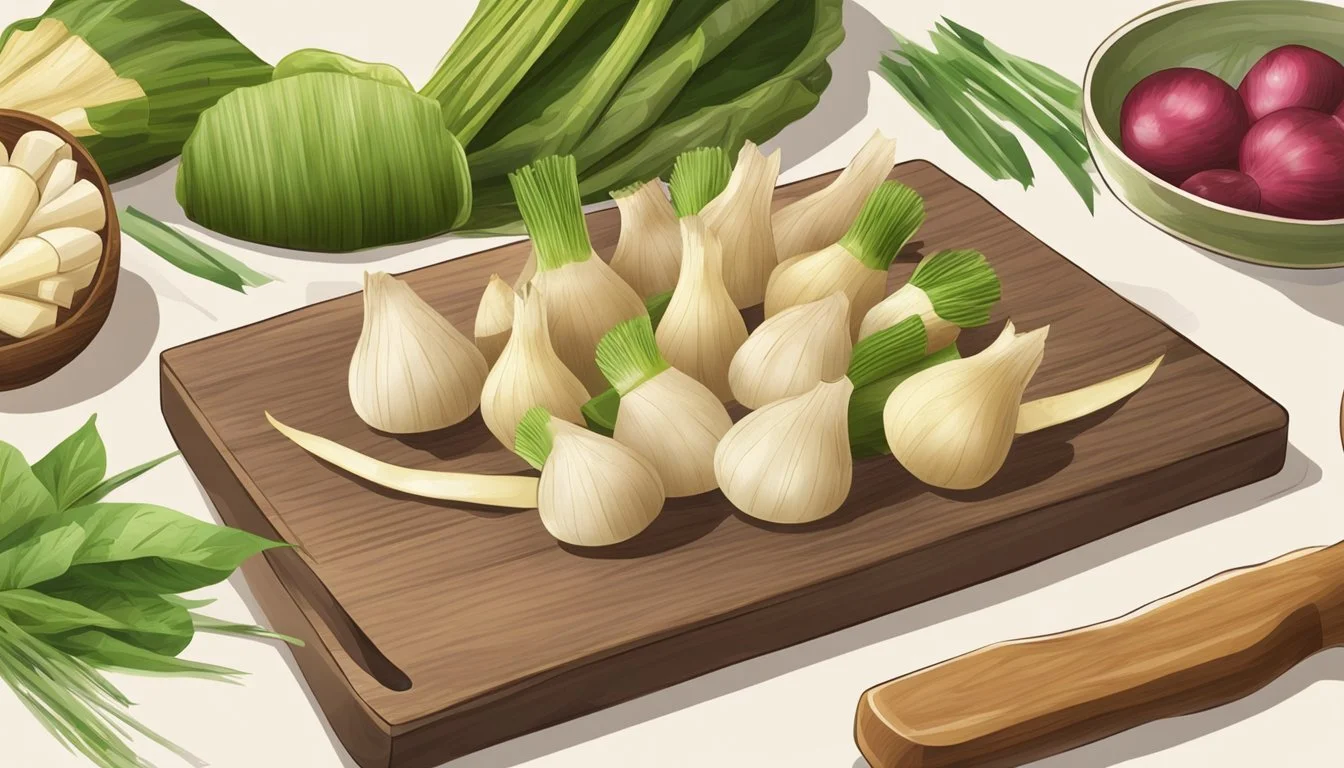How to Substitute Water Chestnuts for Bamboo Shoots
An Easy Guide
Water chestnuts and bamboo shoots are popular ingredients in Asian cuisine, prized for their unique textures and flavors. Water chestnuts, not to be confused with nuts, are actually the corms of an aquatic plant that boast a sweet, mild taste and a satisfying crunch. They are commonly used in stir-fries, salads, and as an accompaniment to many dishes.
Bamboo shoots, on the other hand, are the edible shoots of the bamboo plant, harvested before they become too woody. They have a slightly sweet and nutty flavor with a tender yet crunchy texture, making them a staple in many of the same dishes that call for water chestnuts. While each has its distinctive qualities, cooks may sometimes find the need to substitute bamboo shoots for water chestnuts.
The need for substitutes can arise from availability issues, personal taste preferences, or dietary restrictions. Those seeking to replace water chestnuts with bamboo shoots will find that the latter can bring a similar crunchy texture and a flavor that complements many of the same ingredients. It’s important to note that while bamboo shoots can replace water chestnuts in many recipes, the subtle differences in texture and flavor should be considered to ensure the integrity of the dish is maintained.
Understanding Water Chestnuts
Water chestnuts are a versatile vegetable known for their distinctive crunchy texture and nutritional benefits. They thrive in marshes and are a popular addition to various culinary dishes.
Identifying Water Chestnuts
Water chestnuts are not nuts, but aquatic vegetables that grow in marshes, under the water's surface. They can be identified by their brownish-black skin and a white crunchy flesh inside. They typically have a round, flat shape, and are appreciated for keeping their crisp texture even after being cooked.
Textural Characteristics
One of the defining attributes of water chestnuts is their crunchy texture. This texture is retained in a variety of cooking methods, making them a sought-after ingredient for adding a contrasting bite to dishes. A comparison between water chestnuts and other vegetables, such as bamboo shoots, reveals that while both are crunchy, water chestnuts have a firmer and more refreshing crunch.
Nutritional Profile
Nutritionally, water chestnuts are low in calories yet rich in fiber, which makes them a great option for those looking to manage their weight. A serving of water chestnuts provides ample dietary fiber, essential for digestive health, along with a modest amount of potassium, vitamins, and minerals. This combination contributes to a balanced diet, making them a nutritious component of many meals.
Exploring Bamboo Shoots
When considering bamboo shoots as a substitute for water chestnuts, it's important to understand their distinct characteristics and culinary roles, particularly in Asian cuisine.
Characteristics of Bamboo Shoots
Bamboo shoots are the edible sprouts of certain bamboo species. They have a conical shape, with the top being pointed and the base slightly tapered. The texture of bamboo shoots is often described as tender, yet they retain a desirable crunch when cooked.
Fresh bamboo shoots: They are known for their crisp texture and mildly sweet, nutty flavor.
Canned bamboo shoots: While still tender, they tend to be softer than their fresh counterparts.
In terms of nutritional content, bamboo shoots are low in calories but rich in fiber, vitamins, and minerals, making them a healthful ingredient in various dishes.
Culinary Uses in Asian Cuisine
Bamboo shoots play a pivotal role in the culinary traditions of Southeast Asia. They are a versatile ingredient used in a myriad of dishes, from stir-fries to soups.
Stir-fries: Fresh bamboo shoots are often incorporated for their crunchy texture, enhancing the dish's overall mouthfeel.
Soups and stews: Both fresh and canned shoots are added to soups and broths, providing a contrasting texture to other ingredients.
In many Asian cultures, bamboo shoots are celebrated not only for their texture and taste but also for the nutritional benefits they bring to a dish.
Preparing for Substitution
When replacing water chestnuts with bamboo shoots, it's important to understand the qualities of both. This ensures the substitute not only matches the texture but also complements the flavors of the original ingredient.
Selecting the Right Substitute
Fresh vs Canned Bamboo Shoots: One can choose between fresh or canned bamboo shoots as substitutes for water chestnuts. Fresh bamboo shoots have a more pronounced flavor and crunchiness similar to that of fresh water chestnuts. Canned bamboo shoots, while more accessible, may be softer and less crisp. It's essential to drain them well and possibly give them a quick rinse to remove any tinny taste that might interfere with the dish.
Crunchiness: The ideal replacement for water chestnuts should retain a level of crunchiness when cooked. Bamboo shoots are a favored substitute because they maintain their texture well in both raw and cooked forms. When preparing bamboo shoots, ensure they are sliced or chopped to a size that is comparable to the water chestnuts they're replacing, to achieve a consistent bite throughout the dish.
Consideration of Flavors: Bamboo shoots have a subtle flavor that is different from water chestnuts but still complementary to many of the same dishes. They are a suitable alternative in recipes where water chestnuts are not a central ingredient but are used for their crunchy texture.
By focusing on these key points, one can confidently substitute water chestnuts with bamboo shoots and maintain the integrity of the dish.
Implementing Substitutes in Recipes
When substituting water chestnuts with bamboo shoots in recipes, it's crucial to consider the texture and flavor profile of the dish. Bamboo shoots offer a similar crunch with a slightly different flavor, making them an adaptable alternative.
Substitute Varieties
For dishes that commonly feature water chestnuts, such as stir-fries, soups, and Asian-inspired recipes, there are several substitute varieties that maintain the crisp texture and blend well with the other ingredients. Notable substitutes include:
Jerusalem Artichokes (Sunchokes): These provide a similarly crunchy texture.
Jicama: Adds a mild and slightly sweet flavor, with a crispness comparable to water chestnuts.
Celery: Although softer, celery offers a refreshing crunch.
Turnip: Particularly white turnips, which offer a more subdued flavor.
Radish: Both red and Daikon radishes can give a peppery kick while retaining a firm texture.
Adjusting for Texture and Flavor
Substitutes may require adjustments to preserve the integrity of the dish:
Crispness: Jicama and Jerusalem artichokes maintain a crisp texture well, akin to bamboo shoots.
Flavor: Substitutes like radishes have a stronger flavor and should be used sparingly compared to bamboo shoots.
Mildness: For a milder flavor, apples peeled and cut into matchsticks can be used, offering a sweetness with their crunch.
A side-by-side comparison of substitutes might look like this:
Substitute Texture Flavor Use-case Jicama Crisp Mild/Sweet Ideal in stir-fries and salads Celery Less crisp Refreshing Suitable for soups and savory dishes Turnips Firm Mild Works well in curries and Asian dishes Radish Crisp Peppery Use sparingly for an added kick
Cooking Techniques
Different cooking methods can enhance or preserve the texture of substitutes:
Stir-frying: Quickly stir-frying jicama or celery can maintain their crunchiness.
Boiling: Turnips and radishes should be boiled minimally to preserve their firmness.
Raw: Some substitutes, like apples, may be best served raw to keep their crisp texture prominent.
Alternative Substitutes and Their Uses
When substituting water chestnuts, cooks can rely on the unique qualities of various nuts, tubers, and a range of fruits and vegetables. The selected alternatives should mirror the crunchy and mild taste of water chestnuts while complementing the dish's flavor profile.
Nut and Tuber-Based Substitutes
Turnips and White Turnips: These root vegetables offer a crisp texture. White turnips are less peppery and work especially well in mimicking water chestnut's mild flavor.
Jicama Slices: Jicama provides a refreshing crunch and a subtle sweetness, making it an excellent substitute for water chestnuts in both cooked and raw preparations.
Sunchokes: Also known as Jerusalem artichokes, these tubers have a nutty flavor and remain crunchy when cooked, similar to water chestnuts.
Lotus Root: With a crunchy texture and slightly sweet taste, lotus roots can substitute for water chestnuts in a variety of Asian dishes.
Fruit and Vegetable Options
Hearts of Palm: These provide a gentle crunch and are a fitting alternative in salads where a subtle taste is required.
Apples: With their crispness and light sweetness, apples can impersonate water chestnuts in cold salads and slaws.
Pears: Pears, which are available in many varieties, offer the crunch of water chestnuts with a hint of sweetness suitable for both sweet and savory dishes.
Carrots: When sliced thinly, carrots offer a pleasant crunch and can serve as an alternative to water chestnuts in stir-fries and salads.
Comparing Texture and Flavor Profiles
When substituting water chestnuts with bamboo shoots, it is essential to understand how their texture and flavor profiles compare to predict the outcome in various dishes.
Sensory Comparison
Texture:
Water chestnuts: Crunchy and firm; retain crispness well when cooked.
Bamboo shoots: Generally tender but with some crunch; may become softer when cooked.
Flavor Profile:
Water chestnuts: Possess a mild and slightly sweet flavor; do not overpower other ingredients.
Bamboo shoots: Offer a nutty flavor which can be more pronounced than water chestnuts; might have a bitter taste if not prepared properly.
Differences:
The contrast between water chestnuts and bamboo shoots lies in their nutty versus mild flavor and how these can affect the taste balance in recipes where they are substituted for one another.
Water chestnuts are commonly described as chestnuts due to their similar texture, whereas bamboo shoots are distinct with their slightly nutty and occasionally bitter undertones.
It is clear that while bamboo shoots can replace water chestnuts, the subtle differences in taste and texture should be taken into account to maintain the integrity of the dish.
Nutritional Considerations
When substituting water chestnuts for bamboo shoots, it is important to consider the nutritional value each offers. Both are useful in a balanced diet, providing different vitamins and minerals.
Comparing Dietary Benefits
Water chestnuts and bamboo shoots both serve as low-calorie options high in dietary fiber, making them conducive to digestive health. Water chestnuts, specifically Chinese water chestnuts, are a good source of copper, and vitamins like Vitamin B6. They also provide a beneficial mix of nutrients with negligible amounts of fat and protein.
Bamboo shoots, on the other hand, are notable for their content of fiber and copper, as well as vitamins, including Vitamin B6 and Vitamin E. Compared to water chestnuts, bamboo shoots are richer in minerals such as iron and zinc.
The following table summarizes the nutritional differences between the two:
Nutrient Bamboo Shoots Water Chestnuts Fiber High High Copper Good Higher Vitamin B6 Present Higher Iron More Less Calories Low Low Fat Low Very low Protein Low Very low
This comparison underscores the importance of assessing dietary needs when making substitutions to ensure one's nutritional requirements are met.
Sourcing and Storing Substitutes
When using bamboo shoots as a substitute for water chestnuts, individuals should be aware of the best practices for sourcing and storing these alternatives to maintain their optimal texture and flavor.
Shopping for Substitutes
One should look for fresh bamboo shoots with a firm texture and a smooth skin, indicating their freshness. These can often be found in the produce aisle of Asian groceries or specialty stores. Canned bamboo shoots, which are more readily available, can be found in the international aisle of most supermarkets. When seeking a substitute for fresh water chestnuts, the crunch and mild flavor of bamboo shoots make them an excellent alternative. If a recipe calls for canned water chestnuts, and texture is a high priority, opt for canned bamboo shoots for a similar crunch.
Fresh Bamboo Shoots: Look for firm texture and smooth skin.
Canned Bamboo Shoots: Available in the international aisle.
Storage Tips
Once purchased, fresh bamboo shoots should be peeled, washed, and may be stored in water for a short period. Change the water daily to maintain freshness, and use within two weeks. For extended storage, fresh shoots can be blanched and then frozen. On the other hand, canned bamboo shoots should be stored in a cool, dry place. If not used entirely, they can be refrigerated in a sealed container filled with water to keep them fresh; ensure to change the water every few days.
Fresh Bamboo Shoots:
Peel and wash before storing.
Store in water, change daily.
Blanch and freeze for longer storage.
Canned Bamboo Shoots:
Store unopened cans in a cool, dry place.
Once opened, transfer to a sealed container in the refrigerator.
Fill with water and change every few days.
Additional Insights for Chefs
In professional kitchens where the goal is to create dishes with impeccable flavor profiles and textures, substituting water chestnuts with bamboo shoots can provide a distinct culinary edge. Chefs leverage their expertise to implement this swap in Asian-inspired recipes while maintaining the integrity of the dish.
Creative Usage in Professional Cooking
Chefs often find themselves at the forefront of culinary innovation. Replacing water chestnuts with bamboo shoots in Asian cooking opens doors to a variety of applications. These substitutes are particularly seamless in dishes such as:
Spring Rolls: To maintain the crunch, chefs julienne bamboo shoots offering a textural contrast to the soft fillings.
Stir-Fries: Expertly sautéed bamboo shoots absorb sauces and seasonings, enhancing the overall flavor profile.
Cooking Techniques:
Blanching: Before incorporating bamboo shoots into a recipe, a chef may blanch them to remove any bitterness, ensuring a more neutral taste akin to water chestnuts.
Slicing: Thinly sliced bamboo shoots mimic the shape and bite of water chestnuts, making them perfect for salads and slaws.
Tips from Expert Chefs
Seasoned chefs advise that when using bamboo shoots as a substitute, one should always consider the inherent flavors of the ingredient to complement the dish at hand. They recommend:
Taste Balancing: Bamboo shoots have a more pronounced flavor than water chestnuts. Chefs might adjust seasoning levels to maintain flavor harmony.
Texture Observation: Water chestnuts are known for their unique crispness, so chefs ensure that bamboo shoots are prepared to a similar texture to prevent a disconnect in the dish's expected mouthfeel.
By mindfully incorporating bamboo shoots as a substitute, chefs can elevate a recipe, putting a creative spin on traditional dishes without compromising quality or diner expectations.











